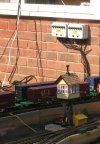curtis
Registered
Folks, I've been pondering this for a while and thought it was best to ask the collective wisdom of this forum.
When building the layout, I ran 4 bus wires - 1 for the Central Station and 1 for a future booster. There are then two others for accessories - an 18v feed and a 12v feed for lighting of buildings and accessories. I am, however, hoping the 18v will be redundant as I'm making an attempt to use 12v LEDs everywhere.
With that context, so the matter at hand. I've been trying to work out how to easily isolate/control sections off the main bus for potential troubleshooting. I have a fear that one day I'll turn on the accessories power and it will not work as somewhere amongst all the buildings, point lamps and signals there is an issue. The idea of troubleshooting that sounds like a nightmare. My instinctive plan was to add toggle switches (on-off) to virtual blocks e.g. from the bus at a particular station - have a switch for station buildings, a switch for station lights, and a switch for signal lamps. The idea here being if my fear manifests, I can simply walk round the garden and switch things off until I find where the issue is.
Is a valid course of action? Any tips on the type of (toggle?) switches to use? I looked at these and considered adding them to the various junction boxes dotted around the layout.
Any thoughts from the forumers?
Curtis
When building the layout, I ran 4 bus wires - 1 for the Central Station and 1 for a future booster. There are then two others for accessories - an 18v feed and a 12v feed for lighting of buildings and accessories. I am, however, hoping the 18v will be redundant as I'm making an attempt to use 12v LEDs everywhere.
With that context, so the matter at hand. I've been trying to work out how to easily isolate/control sections off the main bus for potential troubleshooting. I have a fear that one day I'll turn on the accessories power and it will not work as somewhere amongst all the buildings, point lamps and signals there is an issue. The idea of troubleshooting that sounds like a nightmare. My instinctive plan was to add toggle switches (on-off) to virtual blocks e.g. from the bus at a particular station - have a switch for station buildings, a switch for station lights, and a switch for signal lamps. The idea here being if my fear manifests, I can simply walk round the garden and switch things off until I find where the issue is.
Is a valid course of action? Any tips on the type of (toggle?) switches to use? I looked at these and considered adding them to the various junction boxes dotted around the layout.
Any thoughts from the forumers?
Curtis

